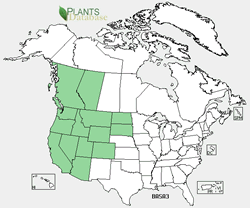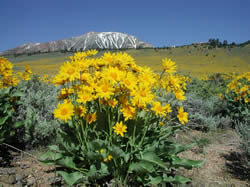USDA Forest Service Celebrating Wildflowers
|
|
|
Plant of the Week
Arrowleaf Balsamroot (Balsamorhiza sagittata (Pursh) Nutt.)This plant's Latin name corresponds with its common name, which in turn well describes the plant. Arrowleaf balsamroot, a plant of the Asteraceae (sunflower family) is fairly common in cold, dry areas of the West, from the Sierra Nevada west to Colorado, and into Canada. It may be found most abundant in mountain fields, but can also be a common plant in the understory of conifer forests. B. sagittata has beautiful, bright yellow flowers: in fact, another common name for it is "Oregon sunflower". Like the rest of the sunflower family, its "flowers" are actually inflorescences composed of numerous tiny flowers (florets) that take up different jobs: each of the ‘petals,' for instance, is actually a single floret bearing one enormous petal and a few minute ones; when taken together, these "ray florets" create the illusion of a ring of petals. The inflorescence is bigger than a silver dollar but smaller than a CD; about the size of a small floppy disk. It can be seen from May to July. The leaves are arrow shaped, meaning that the blades are triangular and pointed. They can be from two-thirds to one and two-thirds of a foot long. The leaf blades are fuzzy, especially on the top (adaxial) side. A large, deep, thick taproot completes the name, having a diameter the width of a hand and a branching root going some feet deep. The thicker portions are covered with bark. The balsam portion of the name refers to a resin in the root. Nearly all parts of this plant were used as food by various Native American groups. The roots may be baked or steamed and eaten, as well as the young shoots. The immature flower stems could be peeled and eaten; the flowers themselves are good browse for wildlife. Balsamroot seeds are nutritious and oil-rich, another good source of food. The root could be used as a coffee substitute. It was also used medicinally. For More Information: PLANTS Profile - Balsamorhiza sagittata, arrowleaf balsamroot |
|
| NOTE: PDF format links require the Adobe Acrobat Reader to view. | |
| top | Disclaimers | FOIA | Privacy Policy | Quality of Information | Photo Credits & Use |
Location: http://www.fs.fed.us/wildflowers/plant-of-the-week/balsamorhiza_sagittata.shtml
Last modified: Tuesday, 24-Jun-2008 21:55:01 EDT


